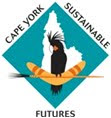Article from NPARC Newsletter Issue 9
Flatback sea turtles on the Cape York West Coast are under threat from feral pigs. In some areas, as many as 100% of nests laid are dug up and eaten! Their future is bleak - if this rate of predation continues, it has the possibility of causing regional extinction within the next 20 years!
However, the flatbacks have some new friends in their fight for survival. Injinoo Land and Sea Rangers, Apudthama Land Trust and NPARC, have been enthusiastic in getting turtle monitoring and feral pig control programs underway. They have been working with Mr Brett Leis, a Turtle Project Officer from the Cape York Sea Turtle Project (managed by Cape York Sustainable Futures), who has been assisting in developing conservation and management strategies, and is providing ongoing training to the Rangers.
Mr Leis said, “The program is aimed at improving the breeding success of endangered sea turtles. It is a race against time. Rangers spend significant time on the beaches collecting data to gather an understanding of turtle nesting numbers, pig activity and predation rates. Transects, sectors and sand plots are set up on nesting beaches such as those in the Jardine area. This information helps in developing management strategies and in implementing cost-effective control programs.”
Angkamuthi Traditional Owners, Apudthama Land Trust and Rangers, have been prioritizing locations for focused aerial culls, baiting and trapping programs. Results to date have been positive. “In some areas, sea turtle hatchlings are returning to the ocean in encouraging numbers for the first time in decades,” said Mr Brett Leis.
























